"La" maceration, a term borrowed from culinary science, evokes the delicate art of transforming and enhancing food through prolonged immersion in aromatic liquids. It is a refined culinary method highly appreciated by cooking enthusiasts. This ancient technique, which has its roots in the necessity of preserving food, has evolved over time to become a prized culinary process, celebrated for its ability to add new flavors "while conferring" notable nutritional benefits. In the following lines, we will explore the metamorphosis of the cabbage, ", of" the onion "and of the" vinegar through maceration, by revealing the molecular transformations that occur and highlighting the benefits of this technique for our health.
Molecular transformation
The cabbage
Cabbage, a cruciferous vegetable with multiple virtues, becomes the protagonist of our culinary adventure. When subjected to maceration, its robust cell fibers relax, thereby facilitating the release of its nutritional compounds. "The" proteins break down into peptides and amino acids, increasing their bioavailability and facilitating digestion. Carbohydrates transform, releasing simple sugars that contribute to a sweet and pleasant flavor.
The onion
The onion, with its pungent flavor and sulfur compounds, transforms when it is pickled. The enzymes contained in the onion begin to break down its cellular structures, softening its bite and releasing sweeter and more complex aromas. Sulfur compounds, known for their anti-inflammatory and antioxidant properties, remain intact and ready to be absorbed.
Vinegar
Le (The) vinegar, acidic and invigorating, plays a crucial role in this molecular ballet. It acts as a catalyst, accelerating the degradation of plant fibers while infusing the food with its characteristic acidity. This acidity, far from being an aggression, helps to preserve the texture of the vegetables, giving them a consistency that is both tender and crunchy, where the tender texture enhances the pleasure of each bite for flavor enthusiasts.
The health benefits
This maceration technique, far from being just a simple gustatory adventure, proves to be a significant ally for our well-being. The vegetables thus transformed become true nutrient powerhouses, easier to digest and assimilate.
Improved digestibility
The enzymatic pre-digestion of proteins and carbohydrates eases the work of our digestive system, making nutrients more accessible and preventing digestive discomfort.
Enhanced antioxidant profile
The sulfur compounds in onions, combined with the naturally occurring antioxidants in cabbage and vinegar, give this preparation a high antioxidant potential, helping to neutralize free radicals and prevent oxidative stress.
Promotion of gut health
The richness in dietary fiber of cabbage, preserved and even enhanced by maceration, promotes good intestinal health, stimulates transit, and contributes to a balanced microbial flora.
Example of delicious recipes
Recipe: Homemade Sauerkraut
Sauerkraut is a classic example of maceration combined with fermentation, a process that not only modifies the structure and taste of the cabbage by adding a touch of flavor, but also increases its nutritional value and health benefits. Here is a detailed explanation of the biochemical transformations involved and the virtues of sauerkraut:
Ingredients:
- 1 kg of white cabbage, finely chopped
- 1.5 tablespoons of sea salt
- 1 teaspoon of caraway seeds (optional)
Biochemical transformations:
- Start of fermentation: When the cabbage is massaged with salt, the maceration process begins. The salt extracts the juice from the cabbage through osmosis, creating an anaerobic (oxygen-free) environment in which the lactic bacteria naturally present on the cabbage can thrive.
- Development of lactic fermentation: These lactic acid bacteria (mainly from the genus Lactobacillus) begin to convert the sugars in the cabbage into lactic acid. This is a form of lactic fermentation. Lactic acid acts as a natural preservative, inhibiting the growth of putrefactive bacteria.
- Degradation of compounds: The enzymes naturally present in cabbage break down complex proteins into simpler amino acids, carbohydrates into simpler sugars, and glucosinolates (sulfur compounds) into isothiocyanates and other compounds, which are recognized for their anticancer properties.
- Development of flavors: As the fermentation As it progresses, the taste of the cabbage softens and takes on characteristic tangy notes. The textures also change; although the cabbage becomes more tender, it retains a certain crunchy texture thanks to the preservative action of lactic acid.
Health benefits:
- Improvement of digestibility: The fibers in cabbage become easier to digest after fermentation. Additionally, the presence of lactic acid promotes a healthy gut flora by stimulating the growth of beneficial bacteria in the digestive tract.
- Strengthening the immune system: The sauerkraut is rich in vitamin C and probiotics, essential for strengthening the immune system.
- Disease prevention: The transformed sulfur compounds have anticancer effects, and the antioxidants present in cabbage, such as vitamin K and carotenoids, are preserved and sometimes amplified by fermentation.
- Nutrient absorption: Fermentation creates certain B vitamins and improves the absorption of minerals by reducing the levels of anti-nutrients present in raw cabbage.
In conclusion, sauerkraut is a compelling example of how maceration and fermentation techniques can transform a simple food into a superfood rich in probiotics and essential nutrients. It attests to the ingenuity of our ancestors in food preservation and the importance of these methods for our contemporary health.
Recipe: Pickled Onions:
Ingredients:
- 1 red onion, finely sliced
- 1 yellow onion, finely sliced
- 125 ml of canola oil or olive oil
- 60 ml of rice vinegar
- Salt and pepper
Preparation:
- In a bowl, mix all the ingredients.
- Add a pinch of salt and pepper to taste.
- Pour into an airtight container and refrigerate for at least 2 hours before using.
- They can be kept for a few days in the refrigerator.
Conclusion
Maceration, much more than a simple preparation technique, proves to be a true gastronomic and health elixir, enriching our culinary recipes. By transforming cabbage, onion, and vinegar into a flavorful and nutritious mixture, it invites us to rediscover foods in a new light, emphasizing that the art of cooking is intrinsically linked to the art of living well and healthily. So, the next time you embark on the adventure of maceration, remember that you are not just preparing a meal: you are participating in an age-old tradition, a tribute to the flavors, textures, and immeasurable benefits of nature's gifts.
Hacène FRIH
Bibliographic references
Abdul Aziz, A. H., Rizkiyah, D. N., Qomariyah, L., Irianto, I., Che Yunus, M. A., & Putra, N. R. (2023). Unlocking the Full Potential of Clove (Syzygium aromaticum) Spice: An Overview of Extraction Techniques, Bioactivity, and Future Opportunities in the Food and Beverage Industry. Processes.
López-Cruz, R., Sandoval-Contreras, T., & Íñiguez-Moreno, M. (2023). Plant Pigments: Classification, Extraction, and Challenge of Their Application in the Food Industry. Food and Bioprocess Technology, 1-17.
Ristovski, B. (2019). Polyphenols in Traditional Sour Cherry Liqueurs - Beverages with Health Benefits.
Sridhar, A., Ponnuchamy, M., Senthil Kumar, P., Kapoor, A., Vo, D.-V. N., & Prabhakar, S. (2021). Techniques and modeling of polyphenol extraction from food: a review. Environmental Chemistry Letters, 19(4), 3409–3443.
Tassi, A. L., Bento, J. A., Caliari, M., Silva, V. S., Pacheco, M. T., Vera, R., & Soares Júnior, M. S. (2020). Physicochemical quality of brown soybean preserve as a function of maceration time and ascorbic acid. Food Science and Technology.
Ueda, J. M., Griebler, K. R., Finimundy, T. C., Rodrigues, D. B., Veríssimo, L., Pires, T. C. S. P., Gonçalves, J., Fernandes, I. P., Pereira, E., Barros, L., Heleno, S. A., & Calhelha, R. C. (2023). Polyphenol Composition by HPLC-DAD-(ESI-)MS/MS and Bioactivities of Extracts from Grape Agri-Food Wastes. Molecules, 28(21), 7368.







